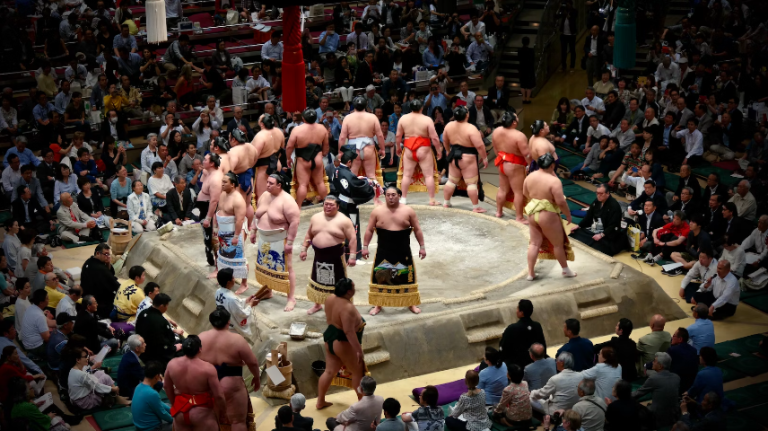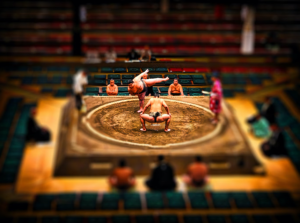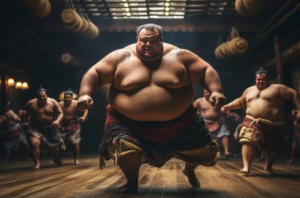Sumo wrestling, a traditional Japanese sport, is renowned for its larger-than-life athletes and captivating matches. Behind the spectacle, however, lies a grueling training regimen that shapes the formidable physiques and skills of sumo wrestlers. In this article, we will delve into the intense world of sumo training, shedding light on the rigorous routines, dietary discipline, and mental fortitude required to excel in this ancient sport.
The Training Dojo: A Sacred Space of Discipline
At the heart of sumo training is the training dojo, or “heya.” These communal training stables serve as the wrestlers’ home, where they live, eat, and train together under the guidance of a stablemaster. The dojo is a place of discipline, where wrestlers dedicate themselves to honing their physical and mental prowess.
Within the dojo, the training regimen of sumo wrestlers is highly structured and demanding. Each day follows a strict schedule that begins before dawn and continues well into the evening. The training routines encompass a range of activities designed to build strength, flexibility, and technique.
- Shiko: Building Lower Body Power. One of the signature exercises of sumo wrestlers is shiko, a series of stomping movements performed with exaggerated leg lifts. This exercise targets the lower body muscles, particularly the thighs and hips, to develop the explosive power needed to drive opponents out of the ring.
- Tachiai: Mastering the Initial Charge. Tachiai refers to the initial charge at the beginning of a sumo bout. Wrestlers practice this essential technique repeatedly, focusing on timing, balance, and the ability to generate force from the legs and core. Tachiai training involves intense pushing and grappling drills to simulate real match scenarios.
- Endurance and Cardiovascular Conditioning. Sumo wrestlers engage in rigorous cardio exercises to build endurance and stamina, as matches can be physically demanding and lengthy. Activities like running, swimming, and cycling help improve cardiovascular fitness and support overall conditioning.
- Weight Training and Resistance Exercises. To enhance their strength and power, sumo wrestlers incorporate weight training and resistance exercises into their regimen. This includes exercises such as squats, deadlifts, and bench presses to develop functional strength and increase muscle mass.
Table. The key training aspects of sumo wrestlers
| Training Aspect | Description |
|---|---|
| Training Dojo (Heya) | Communal stables where sumo wrestlers live, eat, and train together under the guidance of a stablemaster. |
| Daily Training Schedule | Highly structured and demanding, starting before dawn and continuing into the evening. |
| Shiko (Lower Body Power) | Signature stomping exercises targeting lower body muscles, particularly thighs and hips. |
| Tachiai (Initial Charge) | Focused on mastering the initial charge in a sumo bout. |
| Endurance and Cardio Conditioning | Rigorous cardio exercises like running, swimming, and cycling are included to build endurance and stamina. |
| Weight Training and Resistance | Incorporates weight training and resistance exercises like squats, deadlifts, and bench presses to enhance overall strength, functional power, and muscle mass. |
Dietary Discipline: Fueling the Sumo Physique
The remarkable physiques of sumo wrestlers are a result of not only rigorous training but also a specific dietary regimen. Sumo wrestlers follow a diet known as “chanko-nabe,” a nutrient-dense and calorie-rich meal that fuels their bodies for intense training and matches.
- Chanko-Nabe: The Staple Dish. Chanko-nabe is a one-pot stew that contains a variety of ingredients such as protein-rich meats (chicken, fish, or pork), vegetables, tofu, and noodles. This dish provides a balanced combination of proteins, carbohydrates, and fats necessary for muscle growth and sustained energy.
- Caloric Intake and Meal Frequency. Sumo wrestlers consume large quantities of food to support their massive physiques. Their daily caloric intake can exceed 10,000 calories, which is significantly higher than the average person’s requirements. Meals are typically consumed in two large sittings, with a focus on quantity and nutritional balance.
- Balancing Nutritional Needs. While chanko-nabe forms the foundation of their diet, sumo wrestlers also pay attention to nutritional balance. They ensure an adequate intake of vitamins, minerals, and fiber through the inclusion of vegetables and other nutrient-dense foods.
- Weight Management. Despite their large size, sumo wrestlers carefully monitor their weight to compete within specific weight classes. They employ strategies such as adjusting their caloric intake, portion control, and intermittent fasting to achieve and maintain their desired weight.
Mental Fortitude: Cultivating Inner Strength
Sumo wrestling is not just a physical battle; it requires mental fortitude and emotional resilience. Wrestlers must cultivate inner strength to cope with the challenges and pressures of the sport.
- Mental Focus and Concentration. Sumo wrestlers undergo rigorous mental training to develop focus and concentration. They learn to block out distractions and maintain a clear mind during matches, enabling them to react quickly and strategically to their opponent’s movements.
- Rituals and Ceremonies. Sumo wrestling is steeped in tradition and rituals that contribute to the mental preparation of wrestlers. Ceremonies, such as the pre-match purification ritual, help wrestlers enter a state of mental readiness and focus before stepping into the ring.
- Resilience and Perseverance. Sumo wrestlers face numerous setbacks and failures throughout their career. They learn to embrace resilience and perseverance, bouncing back from defeats and setbacks with renewed determination to improve their skills and achieve success.
- Mental Health Support. The demanding nature of sumo wrestling places significant stress on wrestlers’ mental well-being. To address this, support systems are in place within the sumo community, including access to counselors and mentors who provide guidance and emotional support to wrestlers.
So, sumo training encompasses a rigorous and disciplined regimen that shapes the physique, skills, and mental fortitude of wrestlers. From the structured routines in the training dojo to the calorie-rich chanko-nabe diet and the cultivation of mental resilience, sumo wrestlers dedicate themselves to the pursuit of excellence in their craft. The combination of physical strength, technical expertise, and unwavering discipline makes sumo wrestling a captivating and awe-inspiring sport to behold.






+ There are no comments
Add yours